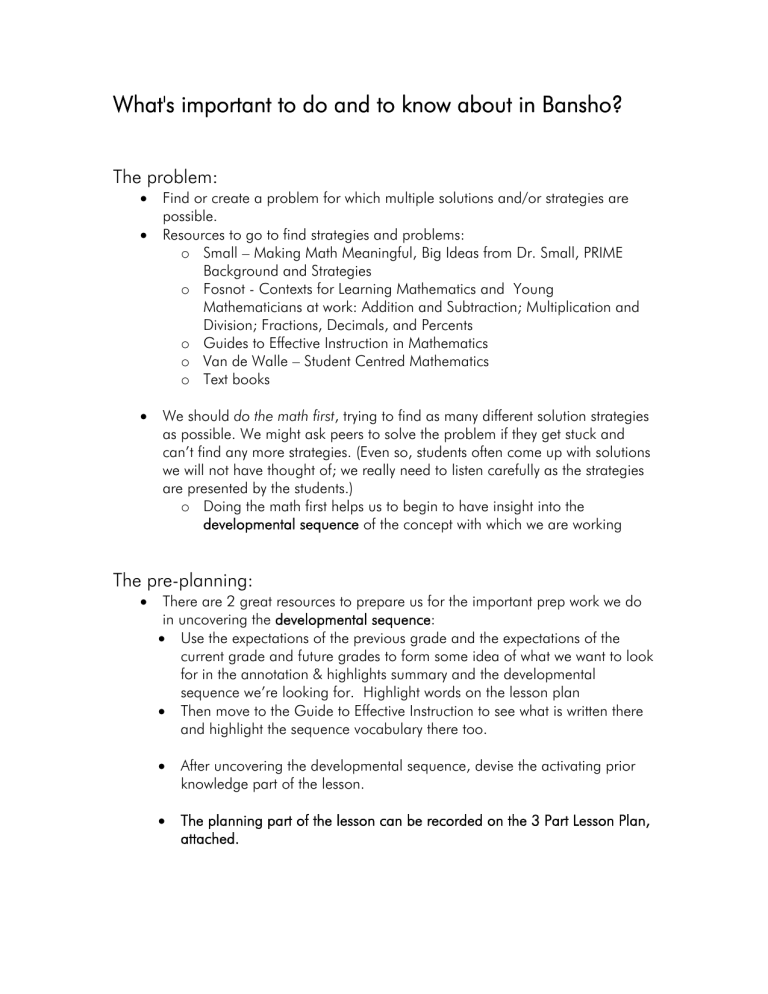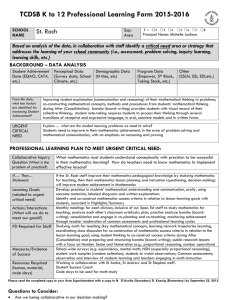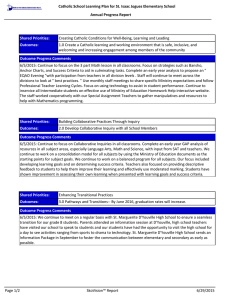
What's important to do and to know about in Bansho? The problem: • • • Find or create a problem for which multiple solutions and/or strategies are possible. Resources to go to find strategies and problems: o Small – Making Math Meaningful, Big Ideas from Dr. Small, PRIME Background and Strategies o Fosnot - Contexts for Learning Mathematics and Young Mathematicians at work: Addition and Subtraction; Multiplication and Division; Fractions, Decimals, and Percents o Guides to Effective Instruction in Mathematics o Van de Walle – Student Centred Mathematics o Text books We should do the math first, trying to find as many different solution strategies as possible. We might ask peers to solve the problem if they get stuck and can’t find any more strategies. (Even so, students often come up with solutions we will not have thought of; we really need to listen carefully as the strategies are presented by the students.) o Doing the math first helps us to begin to have insight into the developmental sequence of the concept with which we are working The pre-planning: • There are 2 great resources to prepare us for the important prep work we do in uncovering the developmental sequence: • Use the expectations of the previous grade and the expectations of the current grade and future grades to form some idea of what we want to look for in the annotation & highlights summary and the developmental sequence we’re looking for. Highlight words on the lesson plan • Then move to the Guide to Effective Instruction to see what is written there and highlight the sequence vocabulary there too. • After uncovering the developmental sequence, devise the activating prior knowledge part of the lesson. • The planning part of the lesson can be recorded on the 3 Part Lesson Plan, attached. Glynnis Fleming DSBN 1 In the classroom: Preparing the materials: • The solutions are recorded in marker of landscape-oriented 11x17 or 8 ½ x 14 paper or ¼ sheet of grid chart paper (when appropriate to the question). This landscape orientation makes it less space-consuming when constructing the bansho. • Put the bansho on a large piece of craft or drawing paper (cut from a roll – 3 m x 1 m) so that it can: o go up over top of the blackboard or whiteboard to leave a clear, uncluttered working space; o be rolled up for instruction of other content; o it can be used in the hall or staff room to promote conversation among staff, students, or parents. Working on it: • Allow students to begin the problem for about 4 minutes. Interrupt to ask: “What is the important information we need in order to solve this problem?” Record this information as it comes from the students and keep it on the far left side of the bansho throughout the entire lesson. • The learning does not happen as the students solve the problem. Therefore it is not necessary that students finish of have the correct answer. It is necessary that they have answers that are sufficiently completed so that a solution strategy emerges. Early finishers can begin to find a 2nd solution pathway on a separate piece of paper. Preparing for the bansho: • The teacher takes the solutions and looks at them during a break or overnight to decide what solution strategies have emerged and the order in which they should be presented. This involves looking at the mathematics present in the solutions; in other words, we must focus on what the students do know, not on what they don’t know. As teachers consider the students’ work, they should look for ways in which the students’ work is connected to each other conceptually. (e.g.: in multiplication, the students will be showing repeated quantities across all solutions.) • Once the teacher has grouped the student work and decided on the strategies or clusters of student work they want to present, they should choose the individual pieces of student work from each strategy or cluster to serve as pieces that represent that strategy well. (These might be called anchors.) There may be as few as 1 strategy or as many as 7 or more. Glynnis Fleming DSBN 2 Conducting the bansho: • As students are presenting the anchors, record (or annotate) directly in their work, adding details where necessary, to make connecting the ideas obvious. As the students are speaking, we need to be asking questions and commenting to draw out the similarities/connecting ideas. These connecting ideas will spring from knowing about the developmental sequence and how the concept develops in the curriculum and from our understanding of the sequence we have read about in the Guide to Effective Instruction on the topic. Only the students who authored the anchor papers present solutions to the class. This coordination of the discussion is where the real learning occurs. • Anchor papers are affixed horizontally near, but not at the bottom, beginning on the left side, immediately to the right of the information the students needed to solve the problem previously recorded at the far left. The category labels will go beneath the anchor papers. Eventually, the students’ work will be added to the bansho upward from the anchor, as in a concrete graph or a pictograph. • Label each category in mathematical language that is accessible to the students – use mathematical language as much as possible. This is usually done as the bansho unfolds. • At the end of the bansho, the teacher highlights the learning with respect to the big idea / key concept for the lesson and records this as a statement directly on the bansho. • • Once the anchors have been presented by their authors, have the students consider where their work belongs with respect to the categories on the bansho. o Teachers of primary students often like to have all students post their work so that each student feels valued o Teachers of junior and intermediate students may or may not want to take the time to post all solutions, leaving just the anchors on the bansho, depending on the level of analysis of the entire bansho that is desired. Discussion might occur about a strategy that the students understood (but didn’t use) that they may like to try next time. They could also choose an expert on that strategy to help them if they get stuck. (Posting the bansho somewhere in the room while the next, related problem is being done can assist as an anchor-chart while students are solving the problem.) Have students work on one related problem for additional practice Glynnis Fleming DSBN 3 Assessment for learning: Planning for next steps: • Plan a related problem for another bansho lesson based on the areas of student learning that ‘need some work’. • Use the student tracking sheet (attached) to record which strategies students are using and the ways in which students are thinking about the mathematics. Transfer this information to an individual student tracking sheet of your own design so that you have accurate information about student achievement at the end of each term for reporting purposes. Graphic of the overall layout of a bansho: Information we need to solve the problem: Highlight/summary : Connection to big idea Student work Student work Student work Student work Student work Student work Student work Count by ones Count by 2s Count by 3s or 4s Student work Repeated addition Glynnis Fleming DSBN 4 What's important to do and to know about in Congress? Teaching and learning in a community of learners / establishing the climate: • • • • • A congress is underpinned by the belief that knowledge emerges in a community of activity, discourse, and reflection. Students put forth their mathematical ideas to the community and justify and defend their thinking. Teachers encourage students to explore, notice patterns, develop efficient strategies, and generalize ideas. Learning happens through ongoing investigations developed within contexts and situations that enable students to engage in mathematics. The math congress provides a forum in which students communicate their ideas, solutions, problems, proofs, and conjectures. The landscape of learning: • There are resources to prepare us for the important prep work we do in uncovering a particular mathematical landscape: • Use the expectations of the previous grade and the expectations of the current grade and future grades to form some idea of what we want to look for in the annotation & highlights summary and the developmental sequence we’re looking for. Highlight words on the lesson plan. • Check The Guides To Effective Instruction, Ministry of Education • Check resources accessible to you that identify research based sequences: Fosnot, Small, Van de Walle. Developing the context: • • • Contexts for investigations are crafted to support the development of big ideas, strategies, and models. Good contexts are situations – either realistic or fictional – that students can imagine, that enable them to realize and reflect on what they are doing, and that will potentially have an effect on mathematical development. Good contexts allow students to make sense of strategies, explore and generate patterns, generalize, and develop the ability to use mathematics to solve problems in their world. Glynnis Fleming DSBN 5 Supporting the investigation: • • • • Ensure that students have appropriate places to work as well as the required materials; Move around the room, observe the strategies that students use, and listen to their discussions; The best questions and comments are designed not to lead students to your answers, but to encourage them to reflect on what they are doing; o “That’s an interesting way to begin.” o “What does this represent?” o “What will you do next?” Keep students grounded in the context if they do not know how to start or lose direction. Preparing for the congress: Students: • • Students require time to record their solutions and discuss what they plan to share. Students could participate in a gallery walk during which they can write questions and sticky notes on peer solutions (this activity allows students to explore ideas in relation to their own solutions and understandings and prepares them for questioning). Teachers: • • Select and order student samples; o Consider how the discussion will be structured. o What ideas deserve discussion? In what order? o Can some of the ideas be generalized? How can it be promoted? o Is there a possible sequence in the discussion that could scaffold the learning? The structure needs to support the development of mathematical knowledge in the room; o Look at what students understand – the point is not to fix the mathematics but to support student development as mathematicians. o Challenge students to think. o Ask them to reflect on inconsistencies or answers that are not reasonable. o Invite them to inquire further. o Wonder with them about appearing patterns. Glynnis Fleming DSBN 6 Conducting the congress: Math congress is not just a whole -class share: • There is not enough time for everyone to share. • Many student strategies will be similar and sharing all would be redundant. Select both the solutions and the order carefully, selection may reflect; • Progressively more efficient strategies, • Solutions that relate to specific big ideas, • Varied representations. As the work is presented, focus the community discussion on the mathematical landscape, big ideas, and generalizations; • Do you agree that this strategy will always work? • Why is this so? • Could we prove it? • When is it helpful? When not? Assessment for learning: Planning for next steps: • Plan a related problem for another lesson based on the areas of student learning that ‘need some work’. • Use the student tracking sheet (attached) to record which strategies students are using and the ways in which students are thinking about the mathematics. Transfer this information to an individual student tracking sheet of your own design so that you have accurate information about student achievement at the end of each term for reporting purposes. Glynnis Fleming DSBN 7 Note: The concept of a math congress originates form the work of Catherine Twomey Fosnot. This overview is adapted directly from this work. Fosnot, C. T. and Dolk, M., 2001a. Young Mathematicians at Work: Constructing Multiplication and Division. Portsmouth, NH: Heinemann. Fosnot, C. T. and Dolk, M., 2001b. Young Mathematicians at Work: Constructing Number Sense, Addition, and Subtraction. Portsmouth, NH: Heinemann. Fosnot, C. T. and Dolk, M., 2002. Young Mathematicians at Work: Constructing Fractions, Decimals, and Percents. Portsmouth, NH: Heinemann. Fosnot, C. T. 2007. Contexts for Learning Mathematics Series. Portsmouth, NH: Heinemann. - Investigating Number Sense, Addition, and Subtraction - Investigating Multiplication and Division - Investigating Fractions, Decimals, and Percents Glynnis Fleming DSBN 8 What's important to do and to know about when doing a “Gallery Walk”? The problem: • • Find or create a problem for which multiple solution strategies are possible. Resources to go to find strategies and problems: o Small – Making Math Meaningful, Big Ideas from Dr. Small, PRIME Background and Strategies o Fosnot - Contexts for Learning Mathematics and Young Mathematicians at work: Addition and Subtraction; Multiplication and Division; Fractions, Decimals, and Percents o Guides to Effective Instruction in Mathematics o Van de Walle – Student Centred Mathematics o Text books When might you use Gallery Walk? • When you want to show different ways of solving a problem quickly • When you know a little diversity of thought will ‘open up’ the way students are approaching a problem • When you want students to begin to relate their thinking to the thinking of others. • How might you use Gallery Walk? • Have all students walk to see each others’ work • Have one partner in a pair that worked together stay to explain their work while the other partner walks; then switch places. (Stay ‘n Stray) • Have students put a constructive idea or a question onto a sticky note for each solution. Variation: Spy Walk • If a student has been given plenty of ‘think time’ and is ‘stuck’, allow them to go on a tour of the classroom to see what their peers are doing. Rule: You may not touch and you may not talk. Students will only come back with what they are capable of understanding. Glynnis Fleming DSBN 9


